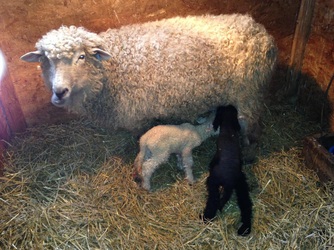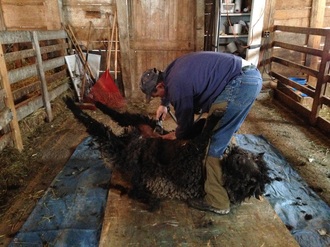 Emmy with her two new lambs, born Saturday. Emmy with her two new lambs, born Saturday. Surprises happen all the time on the farm. Those of you involved in agriculture are well aware... We start breeding our ewes right after the county fair in July, hoping that all lambs will be born before the middle of February. A sheep's gestation period is approximately 148 days, which is why were very surprised to find these two cute lambs in the barn Saturday morning! Counting backwards, this ewe must have been bred the first day they were in with the ram, and run a few days short on her gestation period. This is one of our Hampshire-Lincoln crosses, so its always a surprise to see what colors the lambs end up being. The black one is a ewe lamb and the white one is a ram lamb. They are 7/8ths Lincoln. We had to bring the ewe lamb inside for a few hours due to the temperatures being in the teen's and her brother being a more aggressive nurser. But after sitting by the fire in our living room for a few hours, she's been much more active. Because we are a small hobby farm with only a few lambs at a time, often end up with a few in the house during the winter "just in case". Hopefully this means more lambs will be coming very soon!  Benny, our yearling ram, being shorn. Benny, our yearling ram, being shorn. So after a surprise on Saturday morning, we got to surprise the sheep by shearing. People often ask why we decide to shear at the beginning of winter. It is a bit odd, but we do it for several reasons: 1. We shear in May for the summer and for our shows in the fall, and by the time winter comes around, they have a very long fleece on them. They stay in the barn for most of the winter, so we want to make sure we shear them for a high quality fleece before it gets matted and dirty during the winter in the barn. 2. Our first sheep show is always the first weekend in May, and we like to have a minimum of 12 weeks of wool on the sheep, which means we have to shear in December. 3. Because our sheep have so much wool, lambs sometimes have a hard time finding the udder underneath the mother when they are born. Additionally, we keep a close eye on our ewes when we are expecting lambs, and you can often tell when a ewe is going into labor by a swollen vulva and mucus. These signs are difficult to see with so much wool. On ewes with full fleece, people often "crotch" the ewes, which is shearing just their rump and under the belly, to assist the lamb. We just prefer to shear them. While each sheep is being shorn, someone is nearby skirting the previous sheep's fleece. Skirting is the process of picking through the wool to get out any organic matter, straw, matted clumps, and short or low quality pieces (like stomach or leg wool). We now have about 30 fleeces to do something with! In the coming weeks, we will be packaging all the newly shorn wool to be sent to MacAusland's Woolen Mill and the Finger Lakes Woolen Mill to be made into blankets, yarn and roving. We also will be saving some of the nicer fleeces to be sold as raw fleeces to handspinners. Send us an email if you are interested!
0 Comments
Our semi-annual shearing day is rapidly approaching, and after very successful sales at the NYS Sheep and Wool Festival, we are very interested in having more products made out of our wool. The question is... what will you all buy? If you could take just a second to fill out this quick survey, it will really help us determine what products to spend most of our resources marketing. Thanks! :) |
AuthorEmmaline Long, main owner of Orchard View Farm, has a passion for Lincoln sheep and loves educating others about her breed and farm, She currently serves as the Vice President of the National Lincoln Breeders Association. Archives
October 2020
Categories
All
|
Orchard View Lincoln Longwools7617 S. Lake Rd., Bergen NY 14416 |
Contact UsStay Up-To-DateFollow our blog!
|
